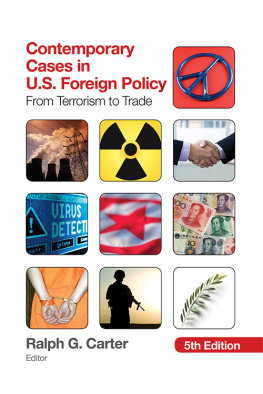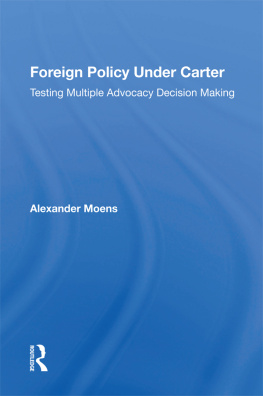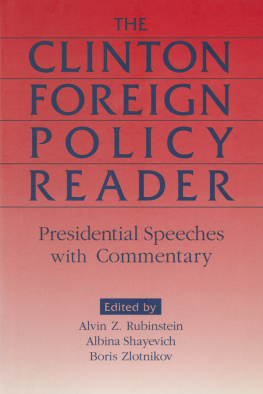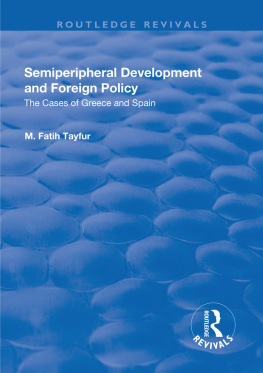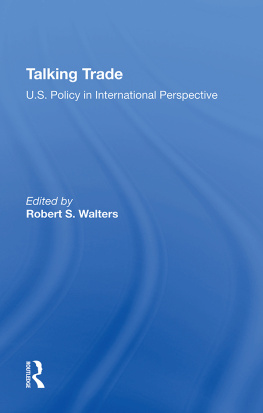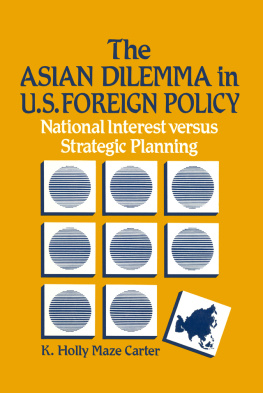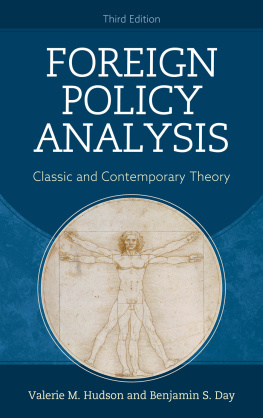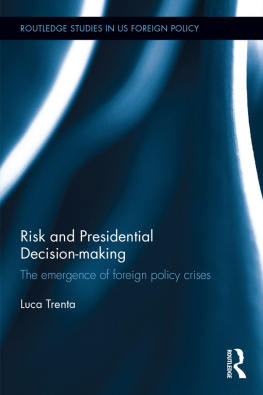Copyright 2014 by CQ Press, an Imprint of SAGE Publications, Inc. CQ Press is a registered trademark of Congressional Quarterly Inc.
All rights reserved. No part of this book may be reproduced or utilized in any form or by any means, electronic or mechanical, including photocopying, recording, or by any information storage and retrieval system, without permission in writing from the publisher.
Printed in the United States of America
Library of Congress Cataloging-in-Publication Data
Contemporary cases in U.S. foreign policy : from terrorism to trade / [edited by] Ralph G. Carter, Texas Christian University. Fifth edition.
pages cm.
Includes bibliographical references and index.
ISBN 978-1-4522-4154-8 (pbk. : alk. paper)
ISBN 978-1-4833-0082-5 (web pdf)
1. United StatesForeign relations1989Case studies.
I. Carter, Ralph G.
E840.C66 2014
327.73dc23 2013009507
This book is printed on acid-free paper.
13 14 15 16 17 10 9 8 7 6 5 4 3 2 1
FOR INFORMATION:
CQ Press
An Imprint of SAGE Publications, Inc.
2455 Teller Road
Thousand Oaks, California 91320
E-mail:
SAGE Publications Ltd.
1 Olivers Yard
55 City Road
London EC1Y 1SP
United Kingdom
SAGE Publications India Pvt. Ltd.
B 1/I 1 Mohan Cooperative Industrial Area
Mathura Road, New Delhi 110 044
India
SAGE Publications Asia-Pacific Pte. Ltd.
3 Church Street
#10-04 Samsung Hub
Singapore 049483
Acquisitions Editor: Charisse Kiino
Editorial Assistant: Lauren Johnson
Production Editor: Stephanie Palermini
Copy Editor: Diana Breti
Typesetter: C&M Digitals (P) Ltd.
Proofreader: Rae-Ann Goodwin
Indexer: Jennifer Pairan
Cover Designer: Edgar Abarca
Marketing Manager: Erica DeLuca
Permissions Editor: Jennifer Barron
Preface
T he terrorist attacks of September 11, 2001 and events thereafter demonstrate that postCold War expectations of a more peaceful world built on a foundation of liberal democracies are, at the very best, premature. Military conflicts and national security issues continue to occupy the spotlight, while less traditional foreign policy concerns have also emerged. Human rights, trade matters, and the U.S. role in the international community have moved to the forefront, as foreign policy making has become a much more complex and crowded affair than it was during the Cold War.
Just as the types of foreign policy issues that seem important have changed, the relative roles played by different policymakers have been in flux as well. Although presidents still act unilaterally when possibleas in decisions to use military forcepresidential preeminence in overall foreign policy making has generally diminished. Domestic and international groups, nongovernmental organizations, and members of Congress now actively challenge the executive branchs ability to direct foreign policy. In the postCold War period, public opinion also seems to play a greater role in policymakers decisions.
This historic shift in the policy process raises a number of questions: Can international institutions contain terrorism or ethnic and religious violence? How can the United States protect its citizens and interests from global terrorist threats? Are unilateral U.S. responses to global threats appropriate, or do they just compound the problem? Will disgruntled domestic actors define new enemies or foreign policy challenges? After the Great Recession, will the international economy be marked by trade wars between regions and free trade within them? What is more important to U.S. foreign policy: human rights or corporate profits and market share? These questions and similar concerns prompted the conception of this book.
Each of the fifteen case studies included here speaks to a foreign policy process that has become more open, pluralistic, and partisan. With the dramatic increase in the number of congressional subcommittees in the 1970s, followed by the explosive growth of the electronic media in the 1980s and 1990s and the social media of the twenty-first century, individuals and groups now have more points of access through which to participate in policy making. These new actors have their own needs, interests, and agendas. They are generally more partisan in their behavior as well, with Democrats and Republicans vying to put their own foreign policy agendas or policy alternatives forward. In short, U.S. foreign policy making now resembles U.S. domestic policy making: It is overtly political.
Most of the cases in this volume reflect the reality of jurisdictional competition between the president and Congress (and, at times, the courts) over the control and direction of foreign policy in the contemporary era. Not only do members of the presidents opposition party often challenge his foreign policy initiatives, but even members of his own party resist executive leadership when they think that the White House tramples on legitimate congressional responsibilities or that the public overwhelmingly opposes administrative policies. Such circumstances have often led to bad blood between the branches, a situation that cannot help but strain the policymaking process. White House controversiesor fundamental changes in governmental direction, such as the 20082009 bailouts of banks and financial institutionscan further open presidents up to challenge by other policy-making actors. These themes combine to reveal the chinks in the armor of the presidential preeminence model of foreign policy making.
Using Case Studies in the Classroom
Although many excellent U.S. foreign policy texts exist, most fall short in their coverage of recent events and debates. This book aims to cover contemporary events, so that instructors can raise issues confronting todays policymakers. Each case study is written expressly for this volume and is organized in a format that emphasizes the substance of events. A textbooks general description of foreign policy making simply cannot capture all of the intricacies, nuances, and subtleties involved in the events chronicled here. The cases starkly reveal the human dimension of policy making and also help instructors show how administrations often take pains to attempt to do things differently than their predecessors. In addition to showing students the human, political, and organizational faces of policy making, these case studies also introduce them to the wide variety of issues and actors found in the postCold War, postSeptember 11, and now postGreat Recession periods. Students are presented with a good story, full of compelling characters and daunting challenges, and information on the relevance of issues and why particular policy choices were made.
The pedagogical benefits of the case study approach have spurred its use within the international studies community, joining military, business, public policy, and public administration schools that have long used this approach. For college graduates to compete and perform effectively in the real world, they must first see the world as it is. Simplified models of reality may be necessary at times, but they are rarely sufficient in and of themselves. Theoretical models alone do not capture the messy nature of foreign policy making. If instructors are to facilitate an understanding of the political arena, in which everything seemingly affects everything else, they must confront students with the policy-making dynamics that real-world cases illustrate. Were policymakers trying to make rational choices? Were they trying to balance power concerns on a regional or global basis? Were they more responsive to external threats or opportunities, or to internal political pressures at home? Were they reacting to widely shared perceptions of reality? Did analogies mold their decisions, or were they merely used to convey or defend decisions to the public? These and other theoretical concerns are addressed through the case study method.




